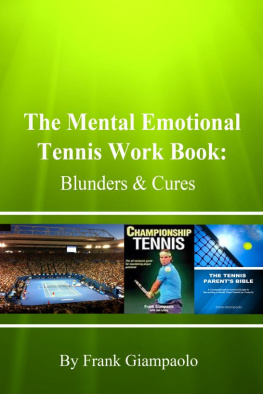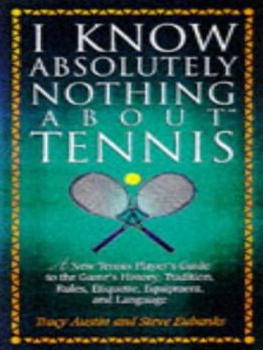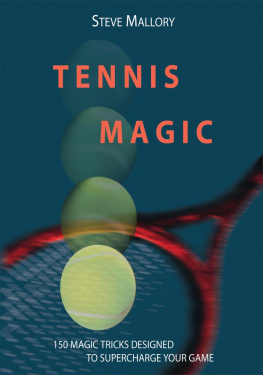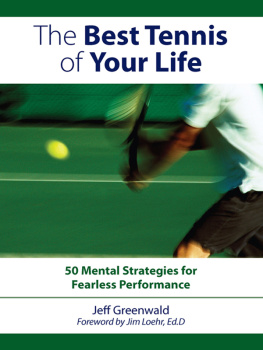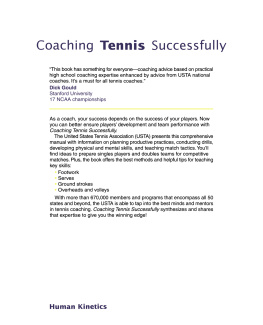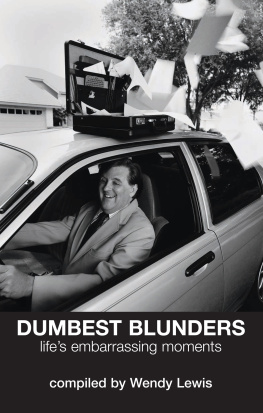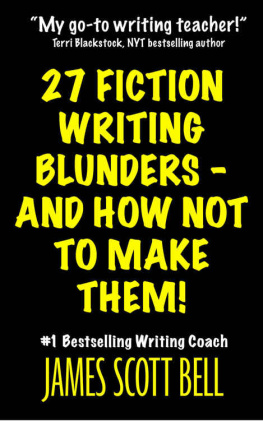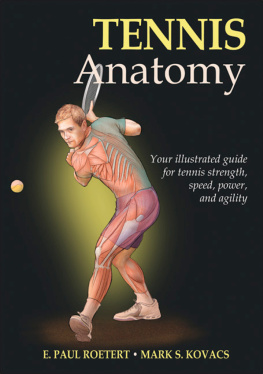THE MENTAL EMOTIONAL TENNIS WORK BOOK:
BLUNDERS AND CURES
By Frank Giampaolo
Copyright 2013 Smashwords Edition
(949)933-8163, FGSA@earthlink.net
http://www.tennisparentsolutions.com
http://www.thetennisparentsbible.com
http://www.mentalemotionaltennisworkshops.com
First Print
Also Available By Frank Giampaolo
CHAMPIONSHIPTENNIS
Human Kinetics Worldwide Publishing
(Available in Print and e-Book Formats)
The Tennis ParentsBible:
A Comprehensive Survival Guide to Becominga
World Class Parent (or Coach)
International Player Evaluation
The Mental Emotional Tennis Work Book:
Insights & Antidotes
The Mental Emotional Tennis Work Book:
Protocols of Winning
The Mental Emotional Tennis Work Book:
Match Chart Collection
The Mental Emotional Tennis Work Book:
Match Day Preparation
The Mental Emotional Tennis Work Book:
How to Attract a College Scholarship
All rights reserved. No part of this materialmay be reproduced in
any form or by any means without the written permission from theauthor.
Photo of Frank by fotograafe
TABLE OF CONTENTS
BLUNDER: Ignoring Your Brain and BodyType
BLUNDER: Not Having an Entourage
BLUNDER: Being an UnaccountablePlayer
BLUNDER: Underestimating the SuccessFormula
BLUNDER: Focusing Only on Strokes
BLUNDER: Overlooking Goal Setting
BLUNDER: Not Knowing Who You Are &What You Do Best
BLUNDER: Neglecting Smart Work
BLUNDER: Encouraging One SetWonders
BLUNDER: Putting Yourself in the Crowdto Get Ahead of the Crowd
BLUNDER: Believing Weekly Lessons areEnough
BLUNDER: Attempting to Fix a FlawedStroke While on the Tournament Trail
BLUNDER: Assuming that Tennis Speed isOnly Foot Speed
BLUNDER: Ignoring Off-CourtTraining
BLUNDER: Ignoring Proper Nutrition andHydration
BLUNDER: Watching Matches versusCharting and Video Taping
BLUNDER: Being In-Flexible
BLUNDER: Playing Up Too Soon
BLUNDER: Refusing to Play Down When ItMight Pump You Up!
BLUNDER: Forgetting You Must BePresent to Win
BLUNDER: Displaying Negative CharacterTraits
BLUNDER: Being Arrogant After FindingSome Success
BLUNDER: Talking about Your Peers
BLUNDER: Focusing Only on Aptitude andOverlooking Attitude
BLUNDER: Misunderstanding ChokingUnder Stress
BLUNDER: Misunderstanding PanickingUnder Stress
BLUNDER: Not Seeing Stumbling Blocksas Stepping Stones
BLUNDER: Perfectionism
BLUNDER: Believing Quantity of CourtTime is Quality Court Time
BLUNDER: Thinking Perfect Strokes areMandatory
BLUNDER: Neglecting the Between Pointand Change Over Rituals
BLUNDER: Ignoring Your B and C GamePlans
BLUNDER: Managing Without aHollywood Script
BLUNDER: Overlooking the PainPrinciple
BLUNDER: Talking at VisualLearners
BLUNDER: Postponing Happiness
Most players spend one hundred percent oftheir time, money and energy on developing their fundamentalstrokes. Yet in competitive match play, they blame their lack ofresults on mental and emotional issues. I have never heard a topranked player walk off the court and cry If I only had followedthrough higher I would of beat that guy! What we do hear day inand day out is I cant stand playing pushers! or I was hookedout of the match! or I was up again 5-2 and choked! or Im sooobadI should just quit! Sound familiar?
The Mental Emotional Tennis Workbooks arecomprehensive problem solving guides for the serious tennis player.The workbooks are designed for both the junior and adultcompetitor. They can be completed in any order, and independentlyof each other. They are designed to assist players through themental and emotional complexities of the game of tennis. Includedare organizational guidelines, time tested formulas for success,foundation essentials, common blunder cures, answers to commonquestions and winning strategies. Also included are educationaltennis tools needed to help identify a players strengths andweaknesses, such as sample weekly and monthly planner, pop quizzes,match charts, match logs and daily focus journals.
Many talented athletes leave the game due toa lack of an organized plan and proper mental and emotionaldevelopment. The aim of these workbooks is to provide the deeperinsights needed to progress in such a challenging individual sport.The days of earning a high ranking while only focusing onfundamental stroke production are long gone.
While five of The Mental Emotional TennisWorkbooks, Match Day Preparation, The Match Chart Collection,Insights and Antidotes, The Protocols of Winning and Blunders andCures, will surely assist you on how to fly, the sixth workbook inthis series, How to Attract a College Scholarship, is designed toteach a junior competitor where to land. Throughout the chapters ofeach workbook, you will notice repetition of some of the mostimportant mental and emotional factors. In my opinion, this is justas important as stroke repetition. It is my intent to hit thereader with these little pearls of wisdom often enough to guaranteethat they sink in.
The mission of The Mental Emotional TennisWorkbook series is to shine a light on the hidden skill setsrequired at the competitive levels of the game. Have fun whilecompleting these workbooks. I am sure that youll agree Theycontain everything you didnt even knowyou needed to know.
Enjoy the journey! Frank
All men make mistakes, but only wise menlearn from their mistakes.
Winston Churchill
Learning from others failures will helpmaximize your potential at the quickest rate. This easy readingworkbook contains some of the most common blunders (problems) foundin competitive tennis. Left untreated, these blunders are often thedownfall of even the best athletes. So to help maximize playerspotential, solutions to each problem are provided.
The work book is organized into Blundertopics and then sub-divided into individual Blunders -BLUNDER, CUREand Ask Yourself. The BLUNDER is the common problem, followed bythe CURE which is the suggested action to be taken to solve theproblem and concludes with Ask Yourself a list of questions tohelp customize your personal plan. The reader is encouraged tonavigate throughout the work book to identify Blunders that bestapply to their situation.
BLUNDER: Ignoring Your Brain and BodyType
Each player has a genetic predisposition toexcel at a particular style of tennis. A common mistake is assumingthat you are wired like your parents, coach and/or siblings.Preferred intelligence is how we see the world and why we mayapproach tasks differently.
Ive found that players with similar braintypes, body types, and personality traits, have similar preferredlearning styles- common obstacles, skills, frustration tolerancelevels, styles of play and decision making abilities. Byunderstanding your brain type you can accelerate learning withcustomized training drills, while saving thousands and thousands ofhours, dollars and wasted tears.
To dig deeper into brain typing I suggest youvisit my friend John Niednagels site: www.braintypes.com or Googlebrain typing.
CURE: Take a few minutes to accurately braintype yourself and maybe even some of your family members. Be sureyour developmental team is on the same page. Digging into yourpreferred learning style will maximize your potential at a quickerrate.
Ask Yourself?
Which brain type are you? Did you learnanything new about yourself from your brain type? How could knowingyour brain type help you practice and preform more efficiently?
Next page
